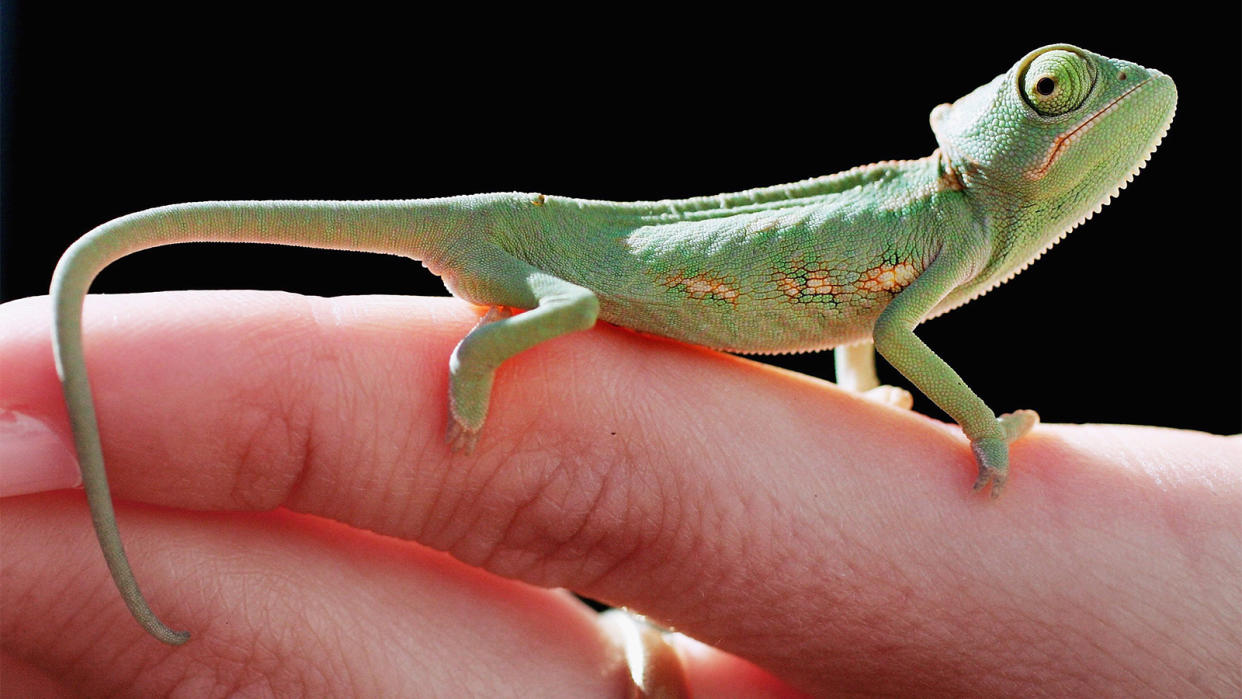How Do Chameleons Change Color? And Why?

Chameleons have built a pretty solid reputation on two commonly held beliefs: They can stealthily blend into their surroundings, and they are the ideal subjects for iconic '80s anthems. But it turns out one of those supposed facts isn't quite right — in fact, everything you think you know about chameleons and their color-changing capabilities is likely backward.
So, how do chameleons change color? The answer is probably not what you're expecting.
What If Your Skin Were a Mood Ring?
"The color-changing properties of chameleons don't really help them blend in, but rather their natural, relaxed state is what helps them blend in," says Daniel Flynn, marketing manager for the Conservation Society of California at the Oakland Zoo.
"The expression 'blending in like a chameleon' isn't entirely accurate, meaning these lizards don't change their appearance to fit in, but rather to stand out."
Iridophores With Color-changing Illusions
Scientists long believed that chameleons change colors similar to the way octopuses switch shades, but biologists and physicists somewhat recently realized that something else entirely is going on.
"The color change you are seeing is based on structural changes of crystal-like cells called iridophores underneath the skin that refract light," Flynn says.
When anything agitates or exhilarates the chameleon, things start to get interesting. "When they get excited, feel threatened, or want to display positively, toward a mate, or negatively, to a rival, the crystals separate or compress and give off the appearance of different colors," Flynn says.
In a 2015 study published in the journal Nature Communications, researchers with the University of Geneva in Switzerland revealed that these special skin cells act like tiny mirrors that selectively reflect light and absorb different colors.
What Colors Are Possible?
No color is off limits to a chameleon. While a lot of animals have color patterns — birds and fish, for example — the cells that make their vibrant displays possible typically absorb or reflect certain regions of the visible light spectrum.
Chameleon skin cells are different from the cells of these animals and other lizards; iridophores can actually absorb or reflect any and all colors of the spectrum, rather than just certain colors.
"Some species change more colors than others," Flynn says. "For example, some will change shades lighter to darker, while others will change to more vibrant, bright colors. There are quite a few species, so there is a lot of variance. Among all of them, they can change all different types of colors — even colors that aren't visible to the human eye!"
Tiny sacs contain the pigments inside the iridophores of a live chameleon, but when the chameleon's mood changes, its nervous system activates these cells, contracting or expanding them.
When the animal is relaxed, the cells stay close together and reflect short wavelengths, like blue. A rush of excitement pushes those cells farther apart, enabling each iridophore to reflect longer wavelengths, like red, orange and yellow.
Defaulting to Green
If a chameleon's naturally relaxed cells reflect blue, why do chilled-out chameleons typically have a green skin color like their surroundings?
"Basically, when a chameleon is relaxed, they are naturally visible as green to help them camouflage with the green leaves and trees," Flynn explains. "This is due to the natural yellow pigment combined with the relaxed state of the crystal cells, which reflect blue light. Blue plus yellow equals green."
It may not be easy being green, but it's necessary for a chameleon, which has no real defenses; blending in using its skin is the best bet against predators for most chameleons.
So, if a chameleon's color changes are due to specialized cells under its skin, why are the effects external?
Transparency
The outermost layer of the chameleon's skin is actually transparent. Beneath that outer layer lies several more layers containing a variety of unique adaptations, including the blue light- and white light-reflecting iridophores.
What's really wild is if a chameleon needs a dramatic quick-change (like when it's trying to attract mates), it can quickly shed its outer layers of skin to expose the iridophores to direct sunlight in a hurry.
Now That's Interesting
There's not a ton of research to support it yet, but some scientists believe chameleons' color-changing abilities also allow them to regulate their body temperature. A 2016 study demonstrated that bearded dragons alter their hue based on their temps, and since chameleons are ectotherms and can't retain body heat (hence their stereotypical sunbathing), it's possible that maintaining a dark color allows them to absorb more heat and light. In other words, a light-colored chameleon may be a cold chameleon.
Original article: How Do Chameleons Change Color? And Why?
Copyright © 2024 HowStuffWorks, a division of InfoSpace Holdings, LLC, a System1 Company


